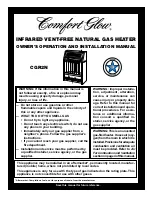
PAGE 22
Q-SERIES DI HEATER OPERATION / MAINTENANCE MANUAL
6
PROCESS INTERLOCKS
The heater is equipped with multiple process fault interlocks to ensure
safe and reliable operation. When a fault is detected the graphical user
interface will change display color (see section 5.1) and indicate the
alarm condition (see section 5.2.b), an audible horn will sound, and power
to the heater modules will be disabled. Pressing the blue RESET button
on the front of the heater will silence the audible horn. After the fault
condition is corrected, the heater can be reset using the blue RESET
button located on the front of heater to resume normal operation.
A troubleshooting guide is included in section 9 to help diagnose and
correct common fault conditions.
CAUTION:
The interlock circuit does not remove hazardous
voltage from the circuit breakers, contactor, and the control transformer.
Only authorized, qualified, trained personnel should service this
equipment.
6.1 LOW FLUID PRESSURE SENSOR
If the fluid pressure decreases below 103 kPa (15 psig) the low fluid
pressure interlock will immediately disable the ability to heat water but will
wait a certain period of time before putting the system into an alarm state.
This delay is intended to eliminate alarm activation and system shutdown
due to instantaneous fluctuations in fluid pressure. During the delay
period the heater is put in a safe state while waiting for the fluid pressure
to increase above 103 kPa (15 psig). If the fluid pressure increases
above 103 kPa (15 psig) before the delay period elapses, the heater will
go back to normal operation without alarming. If the fault condition is not
corrected before the delay period expires, the heater will progress to an
alarm state (see section 5.2.b).
NOTE: The default timeout period is 30 seconds. Contact factory for
instructions on how to adjust this time delay.
6.2 LIQUID LEVEL SENSOR
If the water level is insufficient to fill the heating modules, the liquid level
interlock will immediately disable the ability to heat water but will wait a
certain period of time before putting the system into an alarm state. This
delay is intended to eliminate alarm activation and system shutdown due
to instantaneous fluctuations in liquid level. During the delay period the
heater is put in a safe state while waiting for the fault condition to be
corrected. If the liquid level returns to an appropriate level before the
delay period elapses, the heater will go back to normal operation without










































